In today’s social media age of Facebook, Twitter, Instant Messaging, Skype, Instagram and of course texting, flying from coast to coast in less than five hours is something that most people give very little thought to anymore. I mean let’s face it; the worst part about flying today is being told by some perky flight attendant to turn off your smartphone or other electronic device. Fact is, air travel today is as second nature to us as a Sunday drive to grandma’s house used to be.
Baseball fans today give little thought (if any) when their favorite team is on the road flying from city to city every three or four days every other week; and why should they when they can simply flip on their TVs or fire up their computers or even their smartphones and watch their team play every single day or night like clockwork. But the luxury and convenience of air travel that we pretty much take for granted these days didn’t always exist – especially for MLB teams.
Prior to the 1950s, trains were the primary means of transportation from city to city for MLB teams; but all of that changed in 1948 when the Dodgers became the first franchise in baseball history to use their own airplane to travel from city to city.
The first airplane owned by the Dodgers was a 5-seat twin-engine Beechcraft used almost exclusively by Brooklyn Dodgers president and general manager Branch Rickey in 1948 and 1949 to travel between New York and Vero Beach, Florida for business dealings with Vero Beach businessman Bud Holman. Holman was trying desperately to convince the Dodgers to take over an abandoned World War II U.S. Naval Air base adjacent to the Vero Beach Airport to use as their spring training facility. Needless to say, the Dodgers did exactly that and Dodgertown was born (and its historic stadium later named in Bud Holman’s honor).
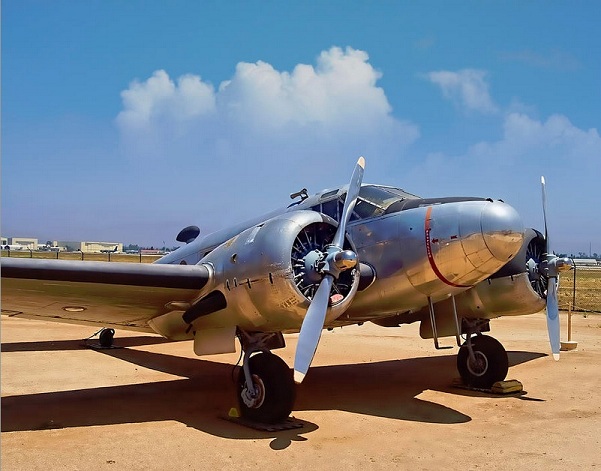
The Dodgers first airplane was a twin Beechcraft similar to this one. (Photo credit – Steve Benefeil)
Dodger owner Walter O’Malley quickly realized the convenience and time-efficiency of flying rather than taking a train (or bus), and began exploring the idea of buying an airplane to transport the Dodgers from city to city. When O’Malley mentioned his idea to Holman, who also happened to be a representative for Eastern Airlines, Bud told him to hold off buying an airplane because he might have a better (and cheaper) way to acquire one.
A few days later, Holman gave O’Malley a used but well maintained DC-3 which he told the Dodger executive he had won in a crap game. The only catch was that O’Malley had to purchase a couple of spare engines at a rather significant cost. O’Malley couldn’t write that check fast enough; thus the Dodgers became the first team in MLB history to have their very own airplane for team travel. The Dodgers used the 20-seat DC-3 from 1949 through 1957.
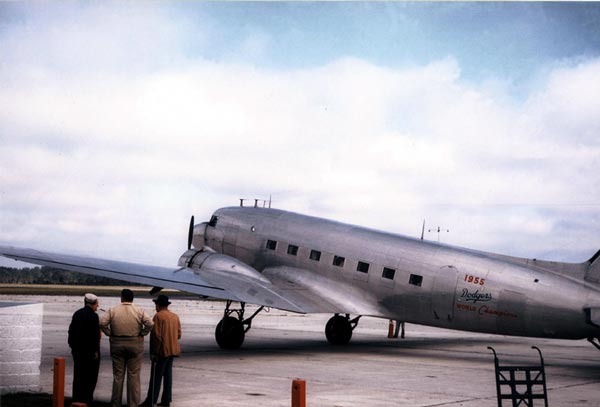
Legend has it that Bud Holman won this DC-3 from Eastern Airlines in a crap game and gave it to Walter O’Malley. (Photo courtesy of walteromalley.com)
Although the Dodgers initially used several different former Eastern Airlines pilots to fly the DC-3, Holman’s son Harry R. “Bump” Holman became the exclusive pilot in 1953 at the age of 21, after having co-piloted the plane since 1949 shortly after his 18th birthday. Although he didn’t know it at the time, young Bump would remain the Dodgers captain for the next 11 years.
Because the DC-3 only seated 20 passengers, it required Bump to make two trips every time the team traveled. As a result of this and because of the improvements in aviation technology, O’Malley decided that they needed a newer and larger airplane; so, in 1957, he purchased a Convair 440, thus making the Dodgers the first MLB team to actually purchase their own airplane (remember that crap game thing).
The Convair had a much longer range and could seat 44 passengers. To save money, O’Malley purchased the Convair as an “add-on” to a 20-plane order placed by his good friend and Eastern Airlines president of Eddie Rickenbacker, the famous World War I ace and Medal of Honor recipient. Rickenbacker agreed to do so and the new plane cost O’Malley $700,000, which was substantially less that it would have cost had O’Malley bought it separately.
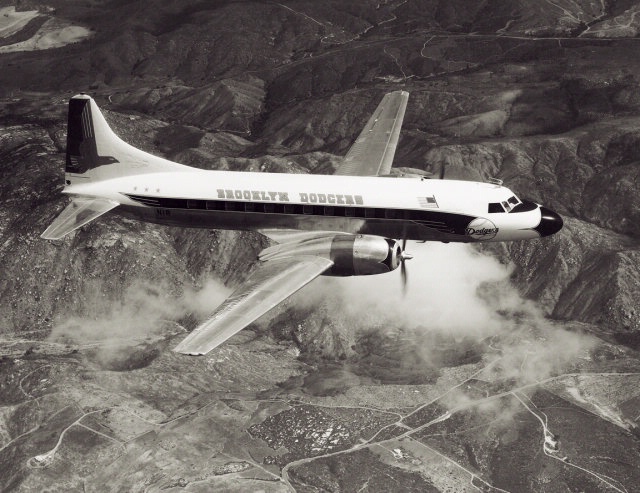
The Dodgers used the Convair 440 from 1957 through 1961.
(Photo courtesy of National Air and Space Museum)
On October 23, 1957, Bump Holman had what was perhaps his most memorable flight as the Dodgers pilot when he flew O’Malley and several other Dodger officials and select players from New York to Los Angeles.
“I flew them out to L.A. and I kind of surprised them,” said Holman. “The day before, I got a sign painter to come out and we painted out ‘Brooklyn’ and put ‘Los Angeles’ on the Convair. I wasn’t supposed to know (that the Dodgers) were moving (to Los Angeles), but I did. We had terrible head winds and we stopped in Oklahoma City for fuel. We were about two hours late. Several thousand cheering fans and officials were still on hand, despite the delay, to greet the arrival of the Dodger airplane,” Holman added.
An Associated Press writer was quick to notice Holman’s handiwork as the next morning’s headline story read: “A smiling O’Malley stepped out of the door first. He was immediately recognized by the crowd and a great roar greeted him. The plane bore in giant letters: “Los Angeles Dodgers.”
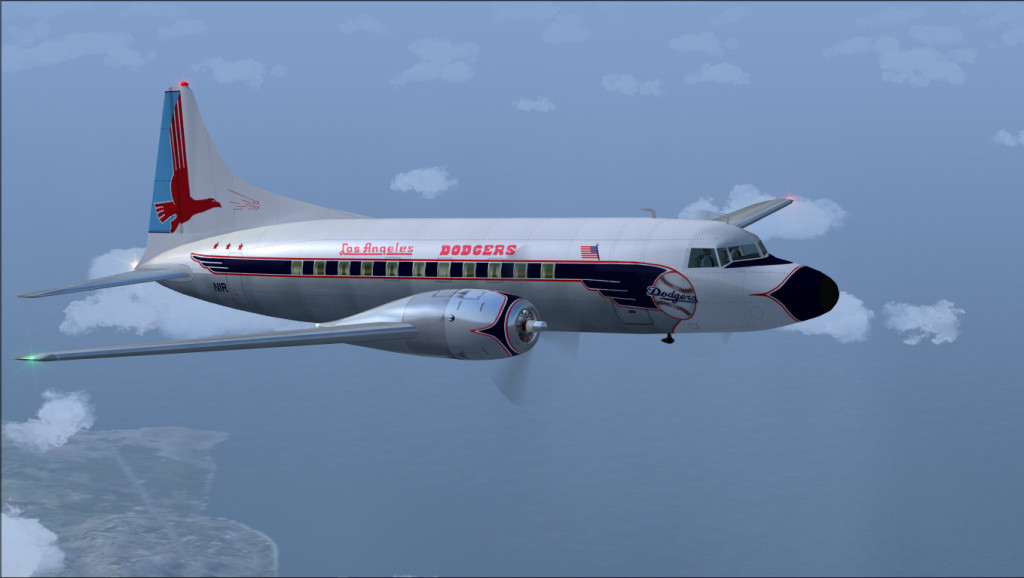
Bump Holman caused quite a stir when he had Los Angeles painted over Brooklyn on the Dodgers Convair 440 before the contract with the City of Los Angeles had even been signed.
(Photo credit – tripletails.weebly.com)
Much to his surprise, Holman did not receive the praise that he anticipated from O’Malley or from his father for his little stunt. “My Dad and Walter were a little bit mad at me about putting that ‘Los Angeles’ on the side,” said the younger Holman. “I think they hadn’t really signed any contracts at that time.” But Holman was quick to add that everyone on the flight was jovial and that “…it was a fun flight.”
After the Dodgers moved to L.A., their air travel miles increased significantly. As such, O’Malley wanted a larger and more efficient aircraft so he sold the Convair for (get this) $700,000. O’Malley initially wanted to purchase a Lockheed Electra II (L-188A) which seated 66 passengers but was told by Lockheed that they would not sell him one because it was a very complex aircraft that required a skilled maintenance crew. O’Malley tried to convince them that they were partners with Eastern Airlines (who owned sixty of them), but Lockheed wouldn’t budge. O’Malley asked Holman what the next best airplane would be, to which Bump told him that a DC-6B was the next best thing.
“Get out of here and go buy the best DC-6B in the world. You have it delivered to Vero Beach and the crew trained by February 15 (1961) for Spring Training,” O’Malley told Holman. “I want four bunks in it and six card tables and anything else you want in the cockpit. Now go get it.”
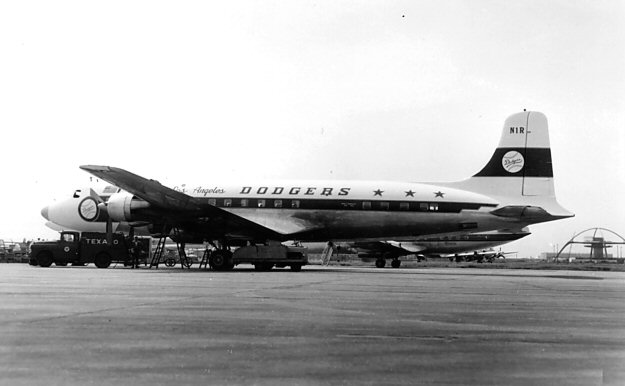
When O’Malley was unable to get the Lockheed Electra II that he wanted, he had to settle for this DC-6B which the Dodgers used for only the 1961 season. (Photo credit – Ed Coates)
No sooner had Bump Holman acquired a used DC-6B from Western Airlines for (get this) $300,000 when he learned that General Motors owned a Lockheed Electra II. (I neglected to mention that Bud Holman also owned a GM car dealership in Vero Beach for 44 years). As it turned out, Lockheed Electras were equipped with Allison engines which were made by General Motors. (I’m not making this stuff up). After some wheeling and dealing, O’Malley bought General Motors’ Electra II for $1.8 million, but it would not be ready until the fall. In the meantime, the team used the DC-6B.
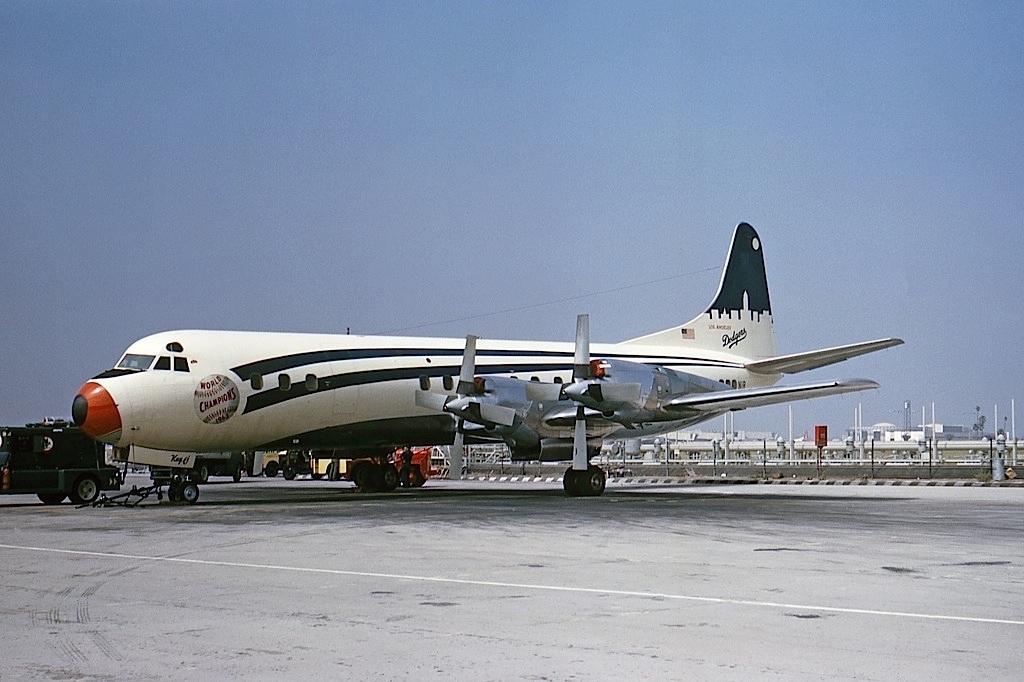
O’Malley finally got his Lockheed Electra II in November of 1961. The “Kay-O” was by far the Dodgers favorite aircraft and remained in service until 1970. (Photo credit Jon Proctor)
As the Electra was being readied, O’Malley again told Holman that he wanted it to have four bunks and six card tables in it. When the plane was delivered in November of 1961, it not only had O’Malley’s four bunks and six card tables in it, but its interior had been designed by a professional interior decorator who had installed special custom carpet that was Dodger Blue with baseballs and bats in its pattern. O’Malley’s wife Kay was so impressed with the new Dodger airplane that Walter named it “Kay-O” in her honor. (By the way, it was rumored that O’Malley sold the DC-6B for $300,000, but you probably already guessed that).
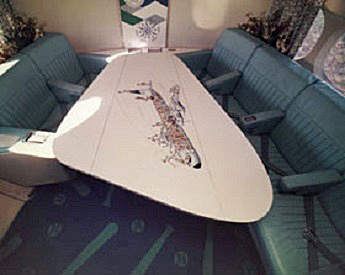
The Electra II had 6 card tables and four bunks. It also had carpet that was custom made in Spain. (Photo courtesy of walteromalley.com)
When Bump Holman retired as the Dodgers pilot in 1964 to take over his late father’s citrus business in Vero Beach, he was replaced in the cockpit by veteran Eastern Airlines pilot Lew Carlisle, who continued flying the Electra until it was replaced in 1970 with a Boeing 720B, thus making the Dodgers the first MLB team to own their own jet which, of course, was named the “Kay-O II.” This would be the last aircraft that Walter O’Malley would purchase, as he died on August 9, 1979.
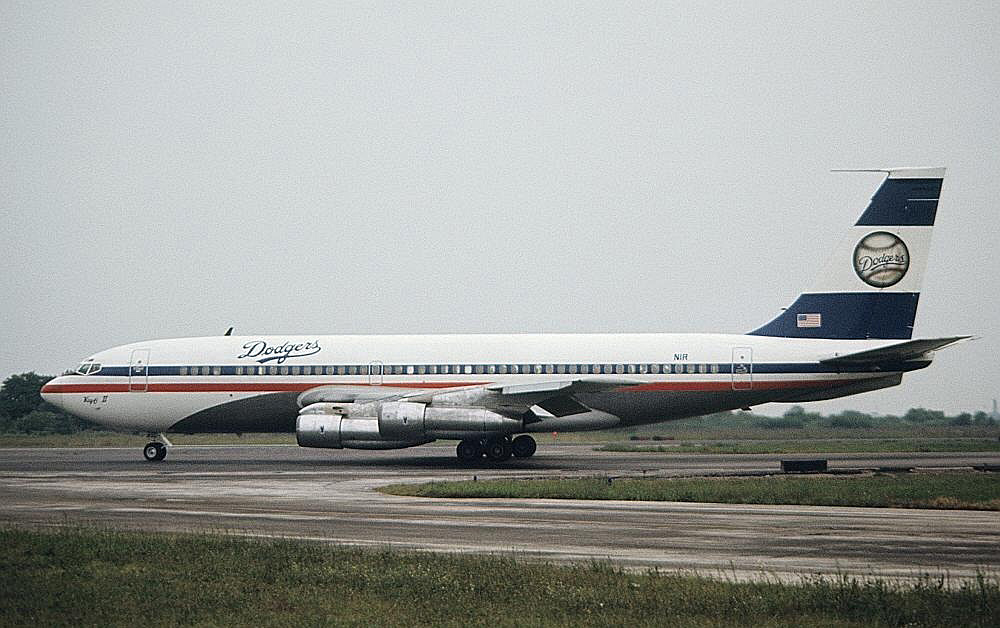
This Boeing 720B was the only jet owned by Walter O’Malley and the Dodgers. (Photo credit – Bob Polaneczky)
Because Carlisle lived in Idaho, the jet was kept at Las Vegas’ McCarran Airport so that he would be (relatively) close to it. Sadly, Carlisle was killed in an accident while vacationing in France in 1982.
With both Walter O’Malley and Lew Carlisle now gone and with soaring maintenance costs, new Dodger owner Peter O’Malley sold the Kay-O II to the Air Force on April 1, 1983 to be used for scrap parts; thus bringing an end to the 35-year flight of the Dodgers. The Kay-O II’s final resting place was Davis-Monthan Air Force Base in Tucson, Arizona – better known as the “DM Boneyard.”
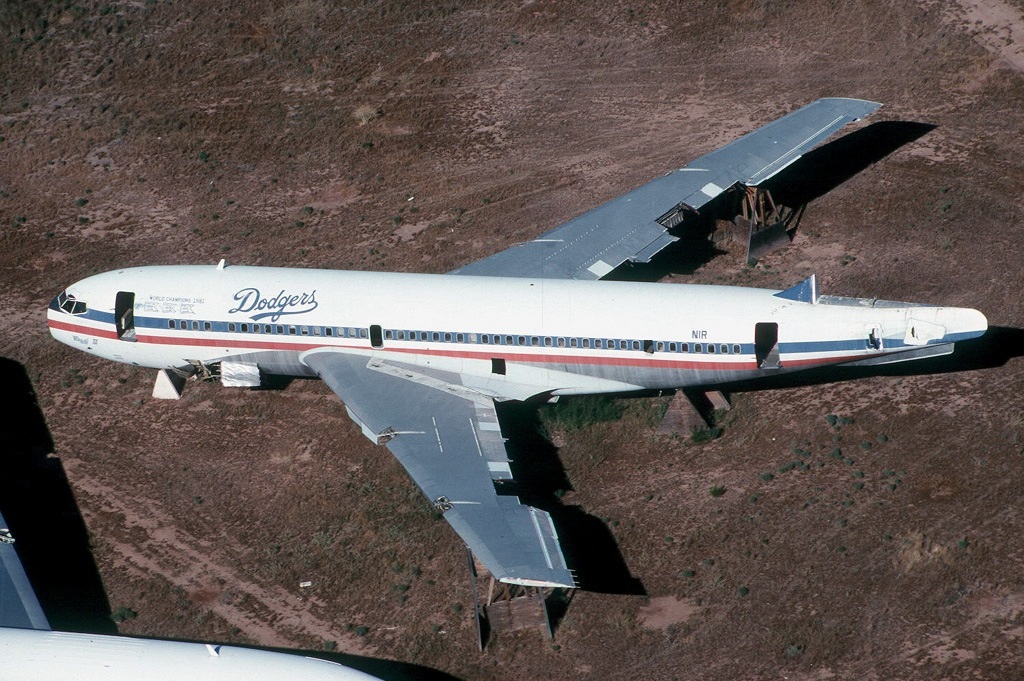
This 1995 photograph shows the unceremonious end to a very prestigious time in Dodger history.
(Photo credit – Derek Hellmann)
The Dodgers currently have a contractual agreement with United Airlines from whom they charter their own plane when traveling. Although I do not know the details of the agreement, it must be rather significant as the Dodgers renamed their luxury suites the ‘United Club Suites’ in 2012.
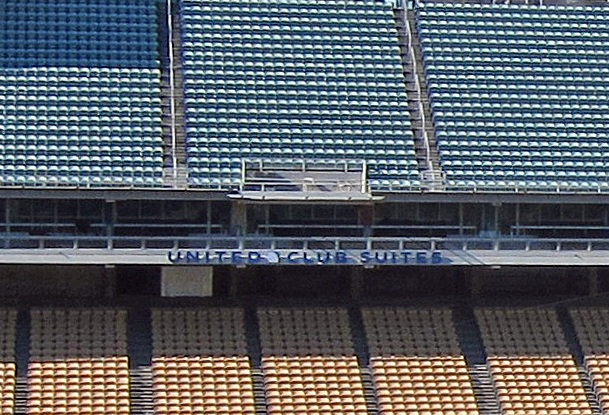
In 2011, United Airlines became the first ever entitlement partner at Dodger Stadium. The sponsorship agreement included renaming the stadium’s luxury suites as the United Club Suites. (Photo credit – Ron Cervenka)
Author’s note: There is an excellent article about Bump Holman by Brent Shyer on the Walter O’Malley website.
(Article re-posted from January 16, 2013)




 January 5th, 2014 at 6:00 am
January 5th, 2014 at 6:00 am  by Ron Cervenka
by Ron Cervenka  Posted in
Posted in 

Thanks, Ron. Once again you’ve hit a home run!
Thanks ebbetsfld. This one took quite a while to put together because I sought out approval to use several of the photographs from their owners, one of whom (Jon Proctor) said that he was a huge Dodger fan back in the 60s – how cool is that!
Ironically, I vividly recall seeing the Dodgers jet at McCarran Airport back in the late 70s and had always wondered what it was doing there. This was well before the Dodgers Triple-A team had relocated from Albuquerque to Las Vegas. Until researching this article, I had simply written it off as O’Malley taking a leisurely trip to Las Vegas. Little did I know that Lew Carlisle actually kept the jet there as its home base.
While researching the article, I also learned of Lew Carlisle’s tragic death in France (Monte Carlo) through a pilots’ forum from a post submitted by the Kay-O II’s former first officer. He said that it was the best job that he ever had, adding that the Dodgers treated him and the rest of the crew like family (go figure). He was with the flight crew in 1981 when the Dodgers won the World Series and was absolutely overwhelmed when Peter O’Malley presented him and the rest of the flight crew with World Series rings. Yet again, how cool it that!
@Think_BlueLA Great piece, Ron! Thanks for the history lesson.
Another great story in the history of the Dodgers, thanks Ron.
Oh, now you’ve stooped to a new high, Ron. Mixing aviation history and baseball. You had me at “flight,” and just made this one of my favorite posts ever.
Thanks for the research and time on this one.
And all those turbo-props! The Elektra was drop-dead gorgeous and quite the work-horse aircraft. Those are some great photos. I will say though, I’m a bit partial the Boeing, being a huge fan of the glory days of early passenger jet airline travel. A lot of people don’t know that the Boeing 720 is actually a short fuselage version of the Boeing 707. The 720 was replaced by the Boeing 727 in 1963.
I knew I’d reel you in with this one, Kevin. If you haven’t already done so, read the linked article from the O’Malley website (it’s very long but a great read). Both Bud and Bump Holman were truly remarkable men; as was Walter O’Malley, of course.
In case you haven’t seen it yet, the DC-3 is depicted in the latest “42” trailer (undoubtedly not the actual plane). I was halfway through this article when I saw that trailer and was extremely excited when I saw that the plane was going to be in the movie – even if only briefly.
Here is the latest 42 trailer.
Great read, Ron. And a real education.
Great article Ron. I often think of the travel involved when the team goes to another city. That must be a difficult part of the job for the players, constantly traveling.
Nice bit of history. Although I think about the travel I have never paid enough attention to it to know the Dodgers no longer have their own plane.
If you recall, Magic Johnson sent his private Gulfstream G-III to Boston to pick up the (then) newly acquired Adrian Gonzalez, Josh Beckett and Nick Punto last August. Although it is not officially a Dodgers aircraft, it is in the Guggenheim family.
Here is Johnson’s G-III (with a tail number is N32MJ – go figure)
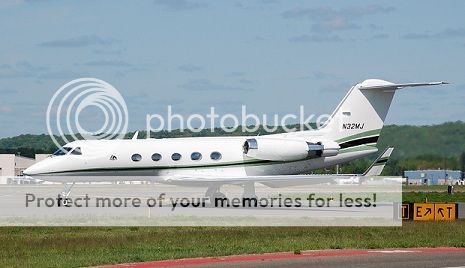
“N32MJ”
Hmmm… MJ? Magic must’ve purchased this Gulfstream from Michael Jordan.
Or MJ…Magic Johnson…#32
Hey, 53! WD-40 does work after all!
That was too easy.
It’s amazing how many things the Dodgers did first. First to put numbers on the front of a jersey. First to have a game televised. First to break the color barrier…and there’s plenty more.
Excellent piece! So many things I didn’t know.
Thanks TTTB81.
Some of your best work Ron. I to remember looking over from Tropicana Blvd next to the hangers in Las Vegas and seeing the Jet parked there many times.
Thank you, Gary. Whereas most articles take me anywhere from 2 to 10 hours to complete, this one took me over two weeks. I was quite pleased with the results.
As tb55 noted, it is simply amazing just how far ahead of the rest of the pack the Dodgers once were. Sadly, the ‘Dodger Way’ is lost and gone forever due to free agency, but perhaps someday they can come reasonably close to it again.
Thankfully, you, me and the rest of the elders got to experience and enjoy the ‘Dodger Way.’
@Alyssa_Milano The Flight of the #Dodgers http://t.co/Q7Icdz0M9Z #MLB
@MagicJohnson The Flight of the #Dodgers http://t.co/Q7Icdz0M9Z … #MLB
I have been a Dodger fan since 1947 (I was only 10 yrs. old) when they were still in Brooklyn. I’ve seen many, many Dodger games including attending the 3rd game they ever played in L.A. at the Coliseum (vs. the hated Giants). I was also a season ticket holder for several years and honored to see them play the Yankees in the 1981 World Series at Dodger Stadium.
My son was especially thrilled when at a game at Dodger Stadium (probably around 1980), coach Mark Cresse presented him with a baseball autographed by the Dodgers.
As an air traffic controller for many years at Los Angeles ARTCC (1968-1990), I controlled N1R, Kayo II (but we fondly referred to it as “Dodger One Roger”) several times, mainly as it returned to LAX from points east and northeast.
Wow! Great stuff, Harry – Thanks!
RT @Think_BlueLA: ICYMI: The Flight of the Dodgers – http://t.co/lbVcdrefTR #Dodgers #Dodgerfam
RT .Think_BlueLA: Never Forget: The Flight of the Dodgers – http://t.co/HiD2qj3M7z #Dodgers #Dodgerfam
Gr8 story planes owned/used by the Dodgers…”The Flight of the Dodgers” | Think Blue LA http://t.co/JRNyTg6FFW
I enjoyed reading this story again as I did a year ago. Fortunately if I wait long enough, I can enjoy a good story or movie as if I was reading or seeing it for the first time.
Hey Joe, I guess if you wait long enough, you can enjoy an Easter Egg hunt for eggs that you have hidden yourself. 😉
[…] from the comments to the last post: Dodgers’ Aviation! As in so many other things, the Dodgers and Walter O’Malley were the first to travel via […]
Two of my favorite topics in one post… Dodgers and aviation.
The Dodgers were once leaders and innovators in the baseball world. I hope they can regain that position.
Yes, one year WS win, with as as ll that money suaundered. Can’t buy everything 😭
Some of this information is incorrect.
1. Eastern only ordered 40 L-188 Electras, not 60.
2. I very much doubt Lockheed, in late 1959, 1960, or early 1961, would have refused to sell the Dodgers a new Electra. Lockheed started delivering Electras to American and Eastern in late 1958. They entered service in January of 1959, and almost immediately, American crashed one into the East River landing at LaGuardia on February 3, 1959, the same day “the music died” when Buddy Holly, the Big Bopper, and Richie Valens, were killed in the crash of a Beechcraft Bonanza shortly after taking off from the Mason City, Iowa airport. That September, a Braniff Electra came apart in the air in good weather on a flight between Houston and Dallas over Buffalo, TX. A few months later, on March 17, 1960, a Northwest Electra, on a flight from Chicago to Miami came apart in clear weather over Tell City, Indiana. There was a call for the grounding of the Electra, but the FAA director, fearing that it was more dangerous to return some older piston engine aircraft to the air, instituted speed restrictions and Lockheed went to work trying to find the culprit that was causing Electras to literally shed their wings. The problem was found, and a fix was instituted, strengthening the Lord Engine Mounts, the engine nacelles and wing structure itself, which stopped the whirl mode, harmonic frequency distortion that caused the wing disintegrate. The aircraft that were subsequently modified were called the “Electra II”. Lockheed released its finding and proposed fix on September 15, 1960. 19 days later, an Eastern Electra crashed taking off from Boston when its engines failed after ingesting birds. Needless to say, the Electra became an aircraft few airlines wanted, and Lockheed which had booked 175 orders never got another order. Additionally, Capital Airlines had ordered five aircraft, but could not pay for them, and when United agreed to takeover Capital, part of the deal was that Lockheed would keep their five Electras. Additionally, Boeing in the mean time, had launched the 727 program, so the Electra was an obsolte airplane. Therefore, I find the story that Lockheed refused to sell the Dodgers an airplane to be suspect, especially with their relationship with Eastern, and the fact they had so called white tails, unsold aircraft from canceled orders on hand. If you look at the Dodgers Convair, it is painted in the Eastern livery with only the fuselage falcon replaced by a baseball and Brooklyn Dodgers replacing, in the same font, Fly Eastern Air Lines, which was painted on the 20 440s Easterns received. Eastern certainly could maintained the aircraft and Los Angeles based Western Air Lines as well as San Diego based PSA were original Electra operators and customers. The second largest Electra operator, American Airlines, that ordered 35 aircraft from the factory, and lost the one in the first Electra crash, started selling off their fleet in 1962. The Dodgers Electra was delivered to GM, perhaps for Allison engine testing purposes, in October of 1958 and sold to the Dodgers three years later. The Dodgers traded it in to American as partial payment for its replacement, an American Boeing 720-023B, N7536A. It later served with Air Califonia for Lake Tahoe Service, and eventually ended up in Canada as an airsprayer and was still active a few years ago, 56 years after it first entered service. As far as the Dodgers 720B, it was retired because after the 2nd oil price shock, the cost of operating it became prohibitive. It was designed when jet-A fuel was 10 cents a gallon.
Great updated information! Thank you.
You did state the reason why Lockheed was reluctant to sell the Dodgers an Electra. Lockheed said that this model required a highly skilled maintenance crew.
If this is the case, at least Lockheed is being a responsible seller. Even with all of the problems that were worked out thru trial and error with airlines and the public. If one of they had all these problems, it was a blessing in disguise. And Lockheed probably did not want to worry about wiping a highly visible and popular team to be assocciated with their brand.
Looking back, even a highly trained maintenance crew did not have the training or experience yet to catch the problems that caused the crashes. Fans should be glad that Lockheed was thick headed about this.
Lew Carlisle living in Idaho had nothing to do with the Dodger jet being parked in Vegas.
First Idaho is not a stones throw by car or small private commuter prop plane to Vegas.
They parked it there because:
It was cheaper than parking it at LAX when they were in town on a homestretch. In other words dropping the Dodgers off at then flying to Vegas and paying to park there was cheaper than to pay the parking fees at LAX sometimes up to 😀10 days.
O’Maley also made an agreement that if he was gong to park the jet at Vegas that they would have the tail end backed up so travelers would see the Dodgers logo on the strip as they drove in and out of Vegas for branding purposes.
Back then the 15 HWY was a road that went right down Las Vegas Blvd. Today the exact same spot is now a helipad Maverick Helicopters.
And lastly Carlisles death had nothing’s no to do with scrapping the jet. As mentioned earlier, it was just a waste of money maintaining a jet that flies once or twice a week when you can just charter one.
seo
The Flight of the Dodgers | Think Blue LA